Identification of Urban Functional Zones Based on the Spatial Specificity of Online Car-Hailing Traffic Cycle
Abstract
:1. Introduction
2. Related Works
2.1. Online Car-Hailing Data
2.2. Identifying Urban Functional Zones
3. Methodology
3.1. Online Car-Hailing Traffic Period Analysis
3.2. Signal Specificity Measurements of Different Periods
3.3. Urban Spatial Partition and Function Identification
3.3.1. Periodic Contribution Matrix
3.3.2. Spatial Clustering
3.3.3. Function Identification of Different Zones
4. Case Study
4.1. Data Description and Experimental Configuration
4.1.1. Study Area and Original Data
4.1.2. Data Processing
4.1.3. Experimental Configuration
4.2. Periodic Signal Analysis
4.3. Contribution Calculation
4.4. Spatial Partitioning Based on Contribution Matrix of Traffic Flow
4.5. POI Analysis and Identification of Functional Zones
5. Conclusions and Discussions
Author Contributions
Funding
Institutional Review Board Statement
Informed Consent Statement
Data Availability Statement
Acknowledgments
Conflicts of Interest
References
- Burlacu, S.; Gavrilă, A.; Popescu, I.M.; Gombos, S.P.; Vasilache, P.C. Theories and models of functional zoning in urban space. Rev. De Manag. Comp. Int. 2020, 21, 44–53. [Google Scholar]
- Zhang, H.; Zhang, L.; Che, F.; Jia, J.; Shi, B. Revealing urban traffic demand by constructing dynamic networks with taxi trajectory data. IEEE Access 2020, 8, 147673–147681. [Google Scholar] [CrossRef]
- Schiavina, M.; Melchiorri, M.; Freire, S.; Florio, P.; Ehrlich, D.; Tommasi, P.; Pesaresi, M.; Kemper, T. Land use efficiency of functional urban areas: Global pattern and evolution of development trajectories. Habitat Int. 2022, 123, 102543. [Google Scholar] [CrossRef] [PubMed]
- Liu, F.; Andrienko, G.; Andrienko, N.; Chen, S.; Janssens, D.; Wets, G.; Theodoridis, Y. Citywide Traffic Analysis Based on the Combination of Visual and Analytic Approaches. J. Geovisualization Spat. Anal. 2020, 4, 15. [Google Scholar] [CrossRef]
- Gao, S.; Liu, Y.; Wang, Y.; Ma, X. Discovering Spatial Interaction Communities from Mobile Phone Data. Trans. GIS 2013, 17, 463–481. [Google Scholar] [CrossRef] [Green Version]
- Srivastava, S.; Vargas-Muñoz, J.E.; Swinkels, D.; Tuia, D. Multilabel building functions classification from ground pictures using convolutional neural networks. In Proceedings of the 2nd ACM SIGSPATIAL International Workshop on AI for Geographic Knowledge Discovery, Seattle, WA, USA, 6 November 2018; pp. 43–46. [Google Scholar]
- Domingo, D.; Palka, G.; Hersperger, A.M. Effect of zoning plans on urban land-use change: A multi-scenario simulation for supporting sustainable urban growth. Sustain. Cities Soc. 2021, 69, 102833. [Google Scholar] [CrossRef]
- Manley, E. Identifying functional urban regions within traffic flow. Reg. Stud. Reg. Sci. 2014, 1, 40–42. [Google Scholar] [CrossRef]
- Reis, J.P.; Silva, E.A.; Pinho, P. Spatial metrics to study urban patterns in growing and shrinking cities. Urban Geogr. 2016, 37, 246–271. [Google Scholar] [CrossRef]
- Huynh, H.N.; Makarov, E.; Legara, E.F.; Monterola, C.; Chew, L.Y. Characterisation and comparison of spatial patterns in urban systems: A case study of US cities. J. Comput. Sci. 2018, 24, 34–43. [Google Scholar] [CrossRef] [Green Version]
- Huang, H.; Yao, X.A.; Krisp, J.M.; Jiang, B. Analytics of location-based big data for smart cities: Opportunities, challenges, and future directions. Comput. Environ. Urban Syst. 2021, 90, 101712. [Google Scholar] [CrossRef]
- Pei, T.; Song, C.; Guo, S.; Shu, H.; Liu, Y.; Du, Y.; Ma, T.; Zhou, C. Big geodata mining: Objective, connotations and research issues. J. Geogr. Sci. 2020, 30, 251–266. [Google Scholar] [CrossRef]
- Wu, T.; Shen, Q.; Xu, M.; Peng, T.; Ou, X. Development and application of an energy use and CO2 emissions reduction evaluation model for China’s online car hailing services. Energy 2018, 154, 298–307. [Google Scholar] [CrossRef]
- Zhang, B.; Chen, S.; Ma, Y.; Li, T.; Tang, K. Analysis on spatiotemporal urban mobility based on online car-hailing data. J. Transp. Geogr. 2020, 82, 102568. [Google Scholar] [CrossRef]
- Brockmann, D.; Theis, F. Money Circulation, Trackable Items, and the Emergence of Universal Human Mobility Patterns. IEEE Pervasive Comput. 2008, 7, 28–35. [Google Scholar] [CrossRef]
- Doyle, J.; Hung, P.; Farrell, R.; McLoone, S. Population Mobility Dynamics Estimated from Mobile Telephony Data. J. Urban Technol. 2014, 21, 109–132. [Google Scholar] [CrossRef]
- Pieroni, C.; Giannotti, M.; Alves, B.B.; Arbex, R. Big data for big issues: Revealing travel patterns of low-income population based on smart card data mining in a global south unequal city. J. Transp. Geogr. 2021, 96, 103203. [Google Scholar] [CrossRef]
- Wolf, J.; Oliveira, M.; Thompson, M. Impact of Underreporting on Mileage and Travel Time Estimates: Results from Global Positioning System-Enhanced Household Travel Survey. Transp. Res. Rec. 2003, 1854, 189–198. [Google Scholar] [CrossRef]
- Hu, S.; Gao, S.; Wu, L.; Xu, Y.; Zhang, Z.; Cui, H.; Gong, X. Urban function classification at road segment level using taxi trajectory data: A graph convolutional neural network approach. Comput. Environ. Urban Syst. 2021, 87, 101619. [Google Scholar] [CrossRef]
- Bogaerts, T.; Masegosa, A.D.; Angarita-Zapata, J.S.; Onieva, E.; Hellinckx, P. A graph CNN-LSTM neural network for short and long-term traffic forecasting based on trajectory data. Transp. Res. Part C: Emerg. Technol. 2020, 112, 62–77. [Google Scholar] [CrossRef]
- Dokuz, A.S. Weighted spatio-temporal taxi trajectory big data mining for regional traffic estimation. Phys. A Stat. Mech. Its Appl. 2022, 589, 126645. [Google Scholar] [CrossRef]
- Loo, B.P.Y.; Huang, Z. Delineating traffic congestion zones in cities: An effective approach based on GIS. J. Transp. Geogr. 2021, 94, 103108. [Google Scholar] [CrossRef]
- Huang, G.; Qiao, S.; Yeh, A.G.-O. Spatiotemporally heterogeneous willingness to ridesplitting and its relationship with the built environment: A case study in Chengdu, China. Transp. Res. Part C: Emerg. Technol. 2021, 133, 103425. [Google Scholar] [CrossRef]
- Coccia, M.; Roshani, S.; Mosleh, M. Scientific Developments and New Technological Trajectories in Sensor Research. Sensors 2021, 21, 7803. [Google Scholar] [CrossRef] [PubMed]
- Qureshi, K.; Abdullah, H. A Survey on Intelligent Transportation Systems. Middle-East J. Sci. Res. 2013, 15, 629–642. [Google Scholar] [CrossRef]
- Raper, J.; Gartner, G.; Karimi, H.; Rizos, C. Applications of location–based services: A selected review. J. Locat. Based Serv. 2007, 1, 89–111. [Google Scholar] [CrossRef]
- Lovelace, R.; Tennekes, M.; Carlino, D. ClockBoard: A zoning system for urban analysis. J. Spat. Inf. Sci. 2022, 24, 63–85. [Google Scholar]
- Santos, C.; Hosseini, M.; Rulff, J.; Ferreira, N.; Wilson, L.; Miranda, F.; Silva, C.; Lage, M. A Visual Analytics System for Profiling Urban Land Use Evolution. arXiv 2021, arXiv:2112.06122. [Google Scholar]
- Yuan, N.J.; Zheng, Y.; Xie, X.; Wang, Y.; Zheng, K.; Xiong, H. Discovering Urban Functional Zones Using Latent Activity Trajectories. IEEE Trans. Knowl. Data Eng. 2015, 27, 712–725. [Google Scholar] [CrossRef]
- Herold, M.; Scepan, J.; Clarke, K.C. The Use of Remote Sensing and Landscape Metrics to Describe Structures and Changes in Urban Land Uses. Environ. Plan. A Econ. Space 2016, 34, 1443–1458. [Google Scholar] [CrossRef] [Green Version]
- Gao, S.; Janowicz, K.; Couclelis, H. Extracting urban functional regions from points of interest and human activities on location-based social networks. Trans. GIS 2017, 21, 446–467. [Google Scholar] [CrossRef]
- Crivellari, A.; Resch, B. Investigating functional consistency of mobility-related urban zones via motion-driven embedding vectors and local POI-type distributions. Comput. Urban Sci. 2022, 2, 19. [Google Scholar] [CrossRef] [PubMed]
- Yu, Q.; Gu, Y.; Yang, S.; Zhou, M. Discovering Spatiotemporal Patterns and Urban Facilities Determinants of Cycling Activities in Beijing. J. Geovisualization Spat. Anal. 2021, 5, 16. [Google Scholar] [CrossRef]
- Gao, F.; Li, S.; Tan, Z.; Liao, S. Visualizing the Spatiotemporal Characteristics of Dockless Bike Sharing Usage in Shenzhen, China. J. Geovisualization Spat. Anal. 2022, 6, 12. [Google Scholar] [CrossRef]
- Zhang, X.; Xu, Y.; Tu, W.; Ratti, C. Do different datasets tell the same story about urban mobility—A comparative study of public transit and taxi usage. J. Transp. Geogr. 2018, 70, 78–90. [Google Scholar] [CrossRef]
- Cai, L.; Xu, J.; Liu, J.; Ma, T.; Pei, T.; Zhou, C. Sensing multiple semantics of urban space from crowdsourcing positioning data. CITIES 2019, 93, 31–42. [Google Scholar] [CrossRef]
- Ratti, C.; Frenchman, D.; Pulselli, R.M.; Williams, S. Mobile Landscapes: Using Location Data from Cell Phones for Urban Analysis. Environ. Plan. B Plan. Des. 2016, 33, 727–748. [Google Scholar] [CrossRef]
- Peungnumsai, A.; Witayangkurn, A.; Nagai, M.; Miyazaki, H. A Taxi Zoning Analysis Using Large-Scale Probe Data: A Case Study for Metropolitan Bangkok. Rev. Socionetwork Strateg. 2018, 12, 21–45. [Google Scholar] [CrossRef]
- Wu, Z.; Huang, N.E. Ensemble Empirical Mode Decomposition: A Noise-Assisted Data Analysis Method. Adv. Data Sci. Adapt. Anal. 2009, 1, 1–41. [Google Scholar] [CrossRef]
- Peng, Z.K.; Tse, P.W.; Chu, F.L. A comparison study of improved Hilbert–Huang transform and wavelet transform: Application to fault diagnosis for rolling bearing. Mech. Syst. Signal Processing 2005, 19, 974–988. [Google Scholar] [CrossRef]
- Han, Z.; Zhu, X.; Li, W. A False Component Identification Method of EMD Based on Kullback-leibler Divergence. Proc. Chin. Soc. Electr. Eng. 2012, 32, 112–117. [Google Scholar]
- Cheng, J.; Yu, D.; Yang, Y. Research on the intrinsic mode function (IMF) criterion in EMD method. Mech. Syst. Signal Processing 2006, 20, 817–824. [Google Scholar]
- Kotan, S.; Schependom, J.V.; Nagels, G.; Akan, A. Comparison of IMF Selection Methods in Classification of Multiple Sclerosis EEG Data. In Proceedings of the 2019 Medical Technologies Congress (TIPTEKNO), Izmir, Turkey, 3–5 October 2019; pp. 1–4. [Google Scholar]
- Xue, S.; Tan, J.; Shi, L.; Deng, J. Rope Tension Fault Diagnosis in Hoisting Systems Based on Vibration Signals Using EEMD, Improved Permutation Entropy, and PSO-SVM. Entropy 2020, 22, 209. [Google Scholar] [CrossRef] [Green Version]
- Song, C.; Pei, T. Research Progress in Time Series Clustering Methods Based on Characteristics. Prog. Geogr. 2012, 31, 1307–1317. [Google Scholar]
- Imaouchen, Y.; Kedadouche, M.; Alkama, R.; Thomas, M. A Frequency-Weighted Energy Operator and complementary ensemble empirical mode decomposition for bearing fault detection. Mech. Syst. Signal Processing 2017, 82, 103–116. [Google Scholar] [CrossRef]
- Di, L. On the Establishment of New National Geographic Grid for National Geographic Conditions Monitoring. Bull. Surv. Mapp. 2011, 12, 1–2. [Google Scholar]
- Gu, Z.; Hübschmann, D. spiralize: An R package for visualizing data on spirals. Bioinformatics 2022, 38, 1434–1436. [Google Scholar] [CrossRef]
- Crooks, A.; Pfoser, D.; Jenkins, A.; Croitoru, A.; Stefanidis, A.; Smith, D.; Karagiorgou, S.; Efentakis, A.; Lamprianidis, G. Crowdsourcing urban form and function. Int. J. Geogr. Inf. Sci. 2015, 29, 720–741. [Google Scholar] [CrossRef]

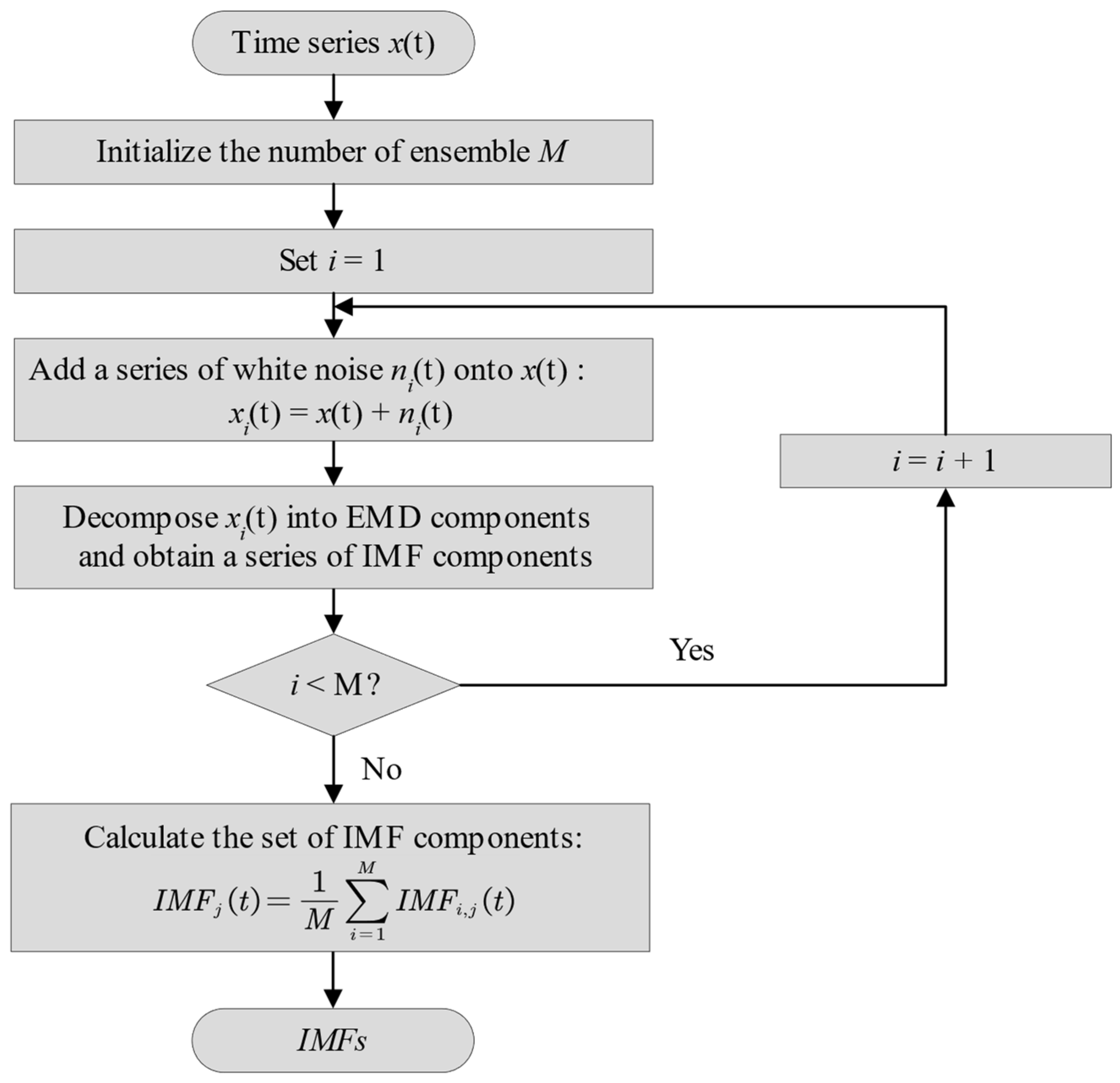

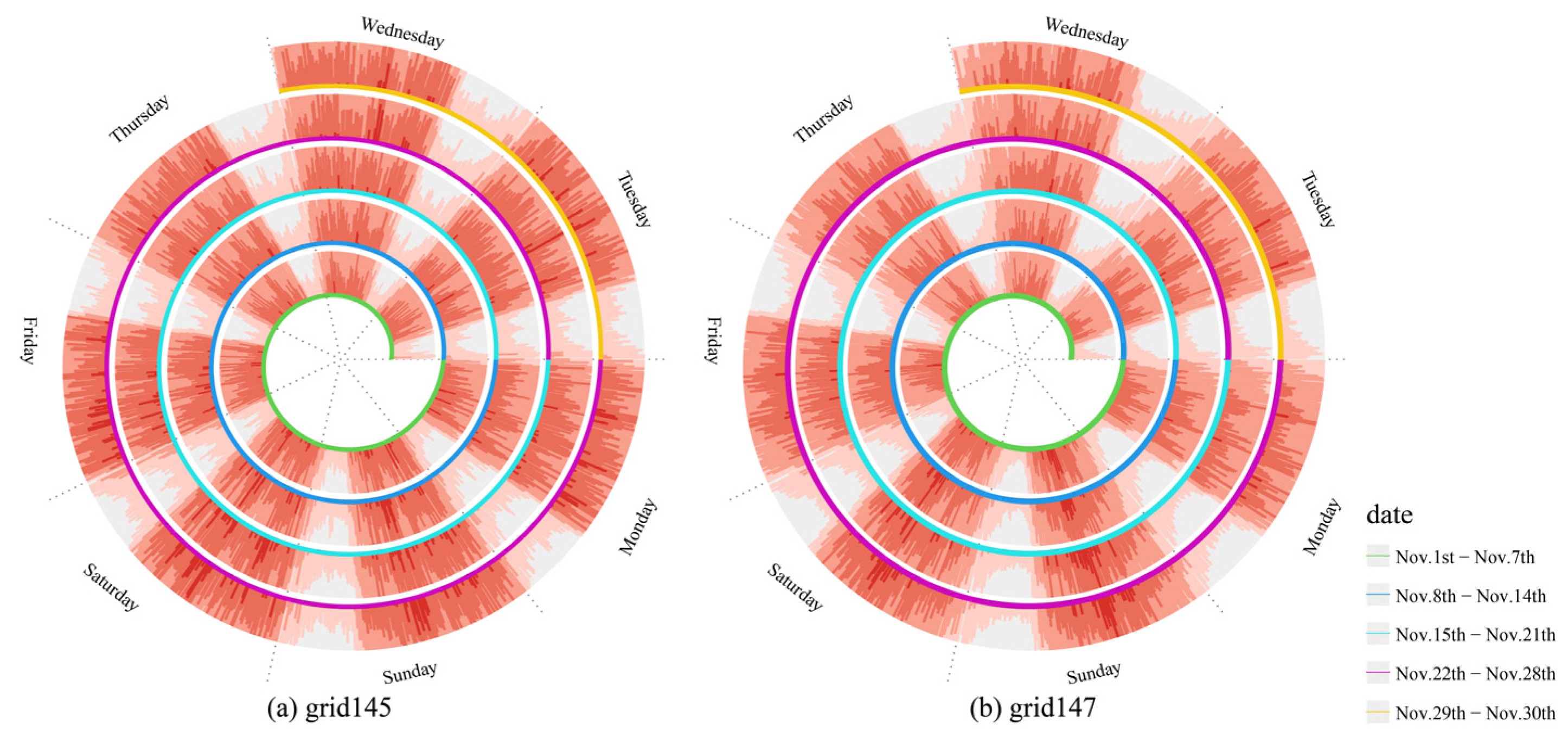
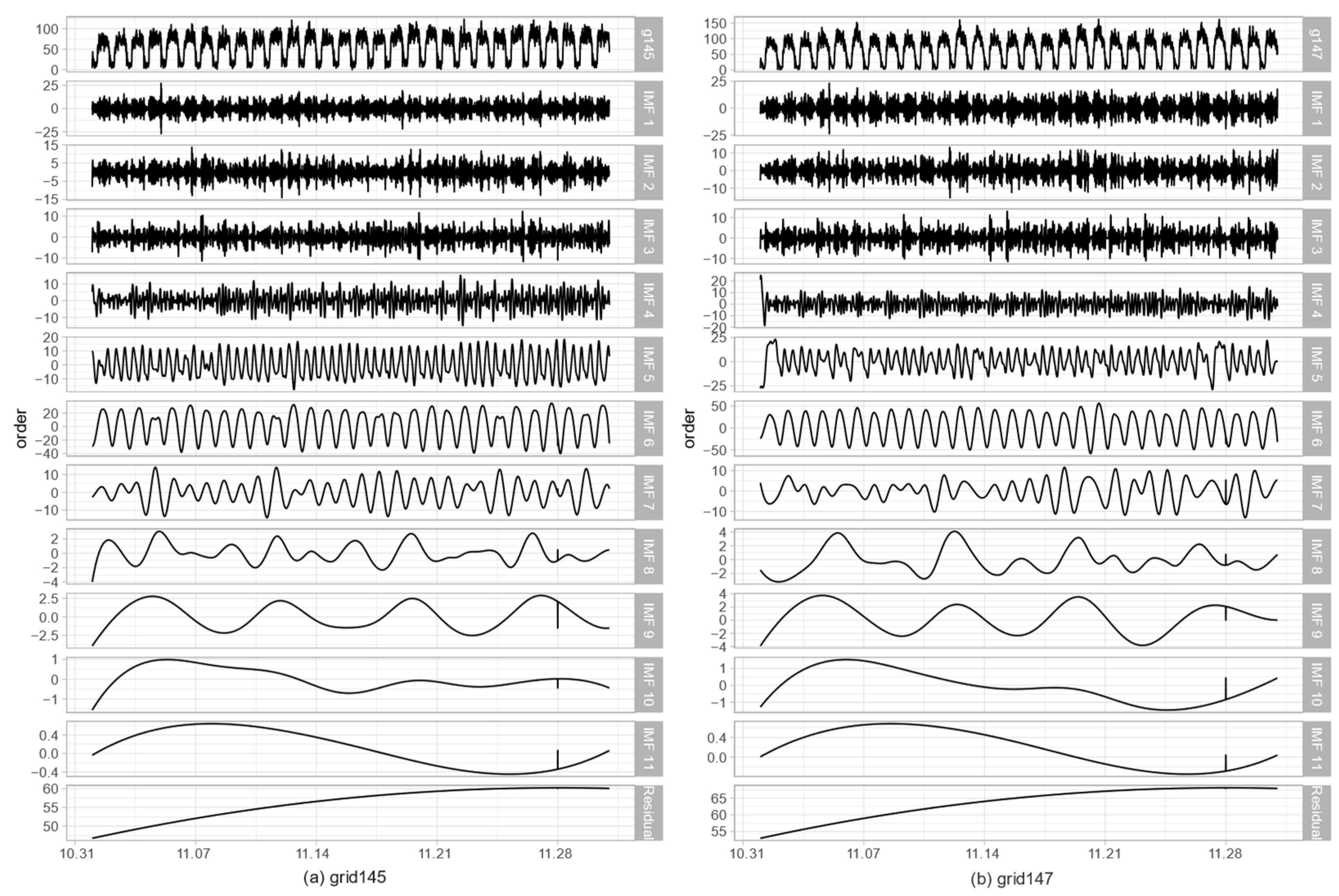
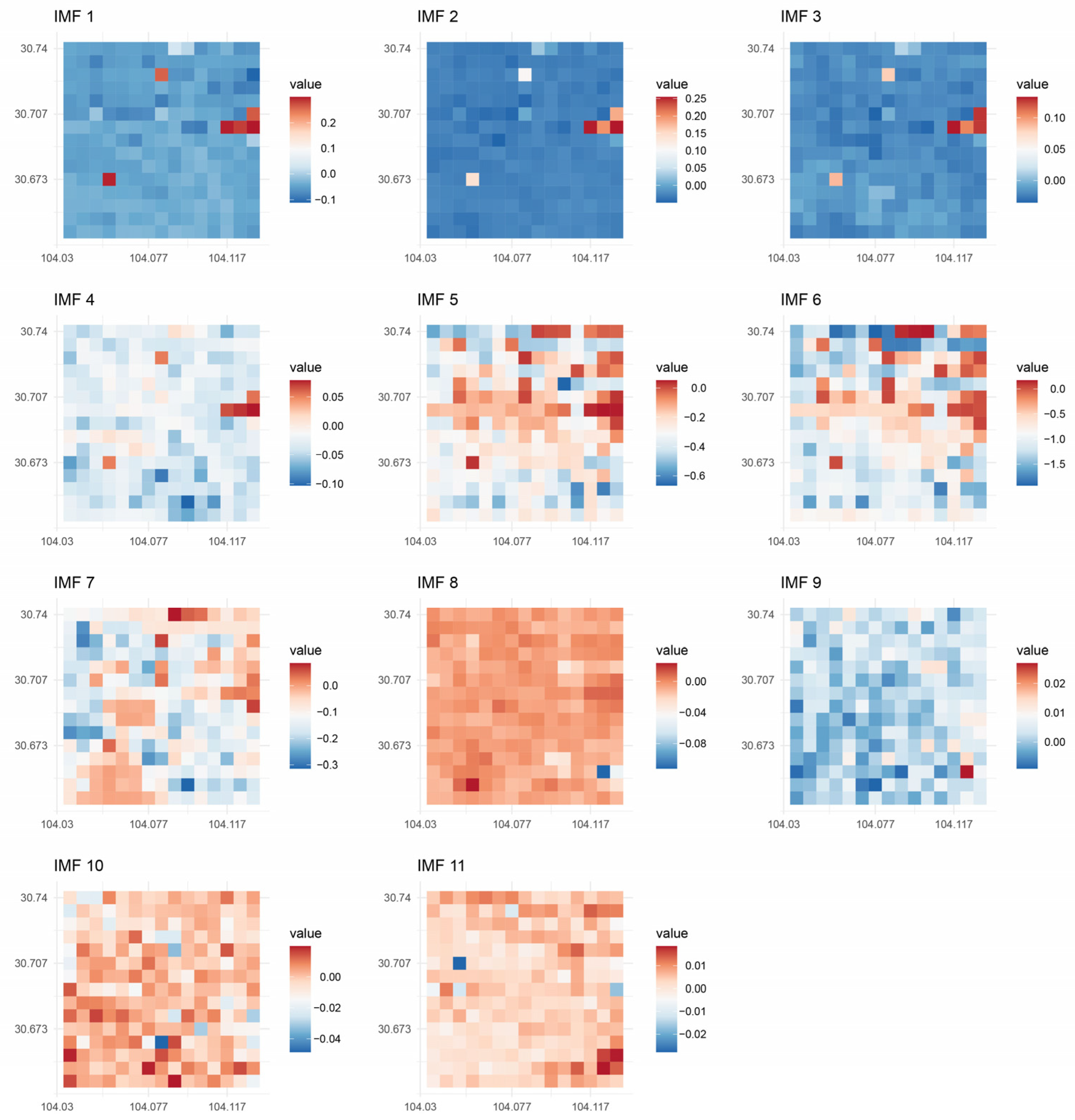


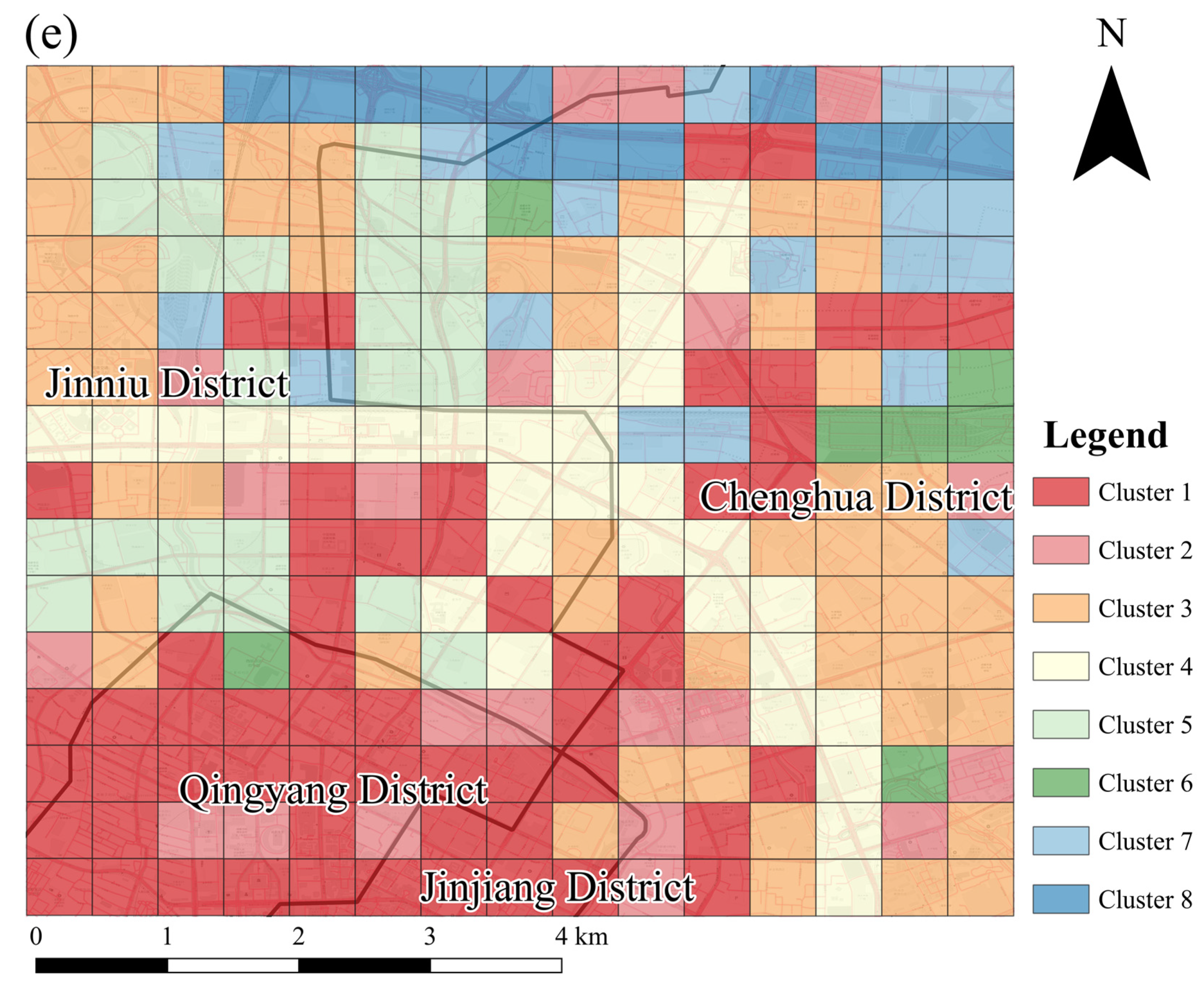
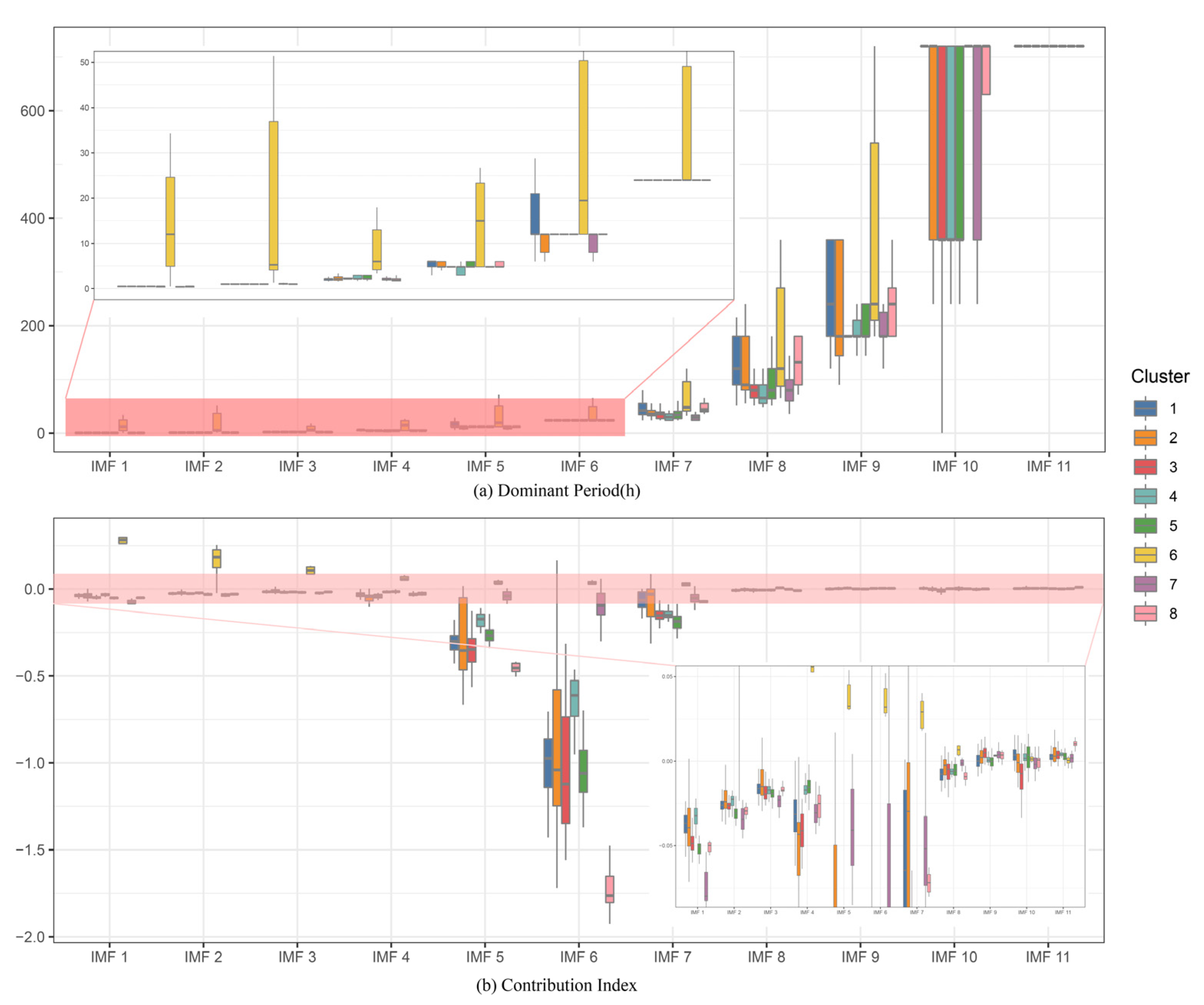
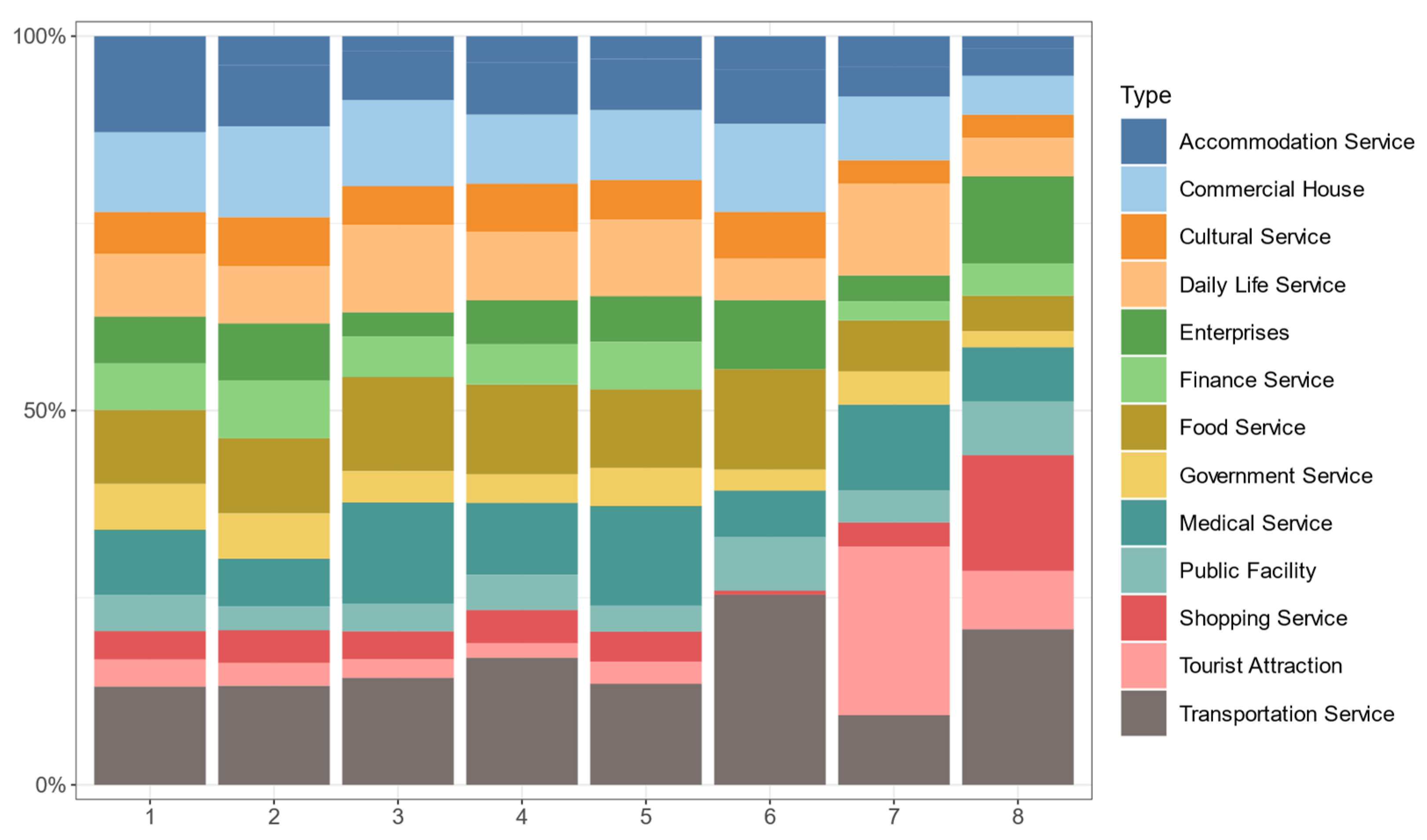
| Symbol | Description |
|---|---|
| original time series at t | |
| the ith superimposed white noise sequence at t | |
| additional noise signal of the ith trial at t | |
| the jth IMF component obtained from the decomposition after the ith addition of white noise at t | |
| residual function after the ith addition of white noise at t | |
| value of the jth IMF of the EEMD decomposition | |
| contribution of the jth IMF component in the kth space unit | |
| value of the jth IMF component in the kth space unit at t | |
| value of the original time series with grid number k at t | |
| length of the time series at grid number k | |
| weight parameter of the ith Gaussian distribution in the mixture model | |
| mean matrices of the ith Gaussian distribution in the mixture model | |
| covariance matrices of the ith Gaussian distribution in the mixture model |
| Name | Type | Example | Remark |
|---|---|---|---|
| Driver ID | String | glox.jrrlltBMvCh8nxqktdr2dtopmlH | Desensitized |
| Order ID | String | jkkt8kxniovIFuns9qrrlvst@iqnpkwz | Desensitized |
| Timestamp | Int | 1501584540 | Unix Timestamp(s) |
| Longitude | Float | 104.04392 | GCJ-02 Coordinate System |
| Latitude | Float | 30.66703 | GCJ-02 Coordinate System |
| grid145 | grid147 | |||
|---|---|---|---|---|
| Dominant Period (h) | Variance Ratio (%) | Dominant Period (h) | Variance Ratio (%) | |
| IMF 1 | 0.4999 | 3.7048 | 0.4999 | 2.4684 |
| IMF 2 | 0.9998 | 1.2601 | 0.9998 | 0.8610 |
| IMF 3 | 2.9993 | 1.0458 | 2.1813 | 0.7433 |
| IMF 4 | 4.7989 | 2.3878 | 4.7989 | 1.9501 |
| IMF 5 | 11.9972 | 8.0102 | 11.9972 | 6.4739 |
| IMF 6 | 23.9944 | 46.1930 | 23.9944 | 58.5544 |
| IMF 7 | 23.9944 | 4.1123 | 23.9944 | 1.6154 |
| IMF 8 | 89.9792 | 0.1712 | 179.9583 | 0.1962 |
| IMF 9 | 179.9583 | 0.3137 | 179.9583 | 0.2901 |
| IMF 10 | 719.8333 | 0.0283 | 719.8333 | 0.0519 |
| IMF 11 | 719.8333 | 0.0164 | 719.8333 | 0.0087 |
Publisher’s Note: MDPI stays neutral with regard to jurisdictional claims in published maps and institutional affiliations. |
© 2022 by the authors. Licensee MDPI, Basel, Switzerland. This article is an open access article distributed under the terms and conditions of the Creative Commons Attribution (CC BY) license (https://creativecommons.org/licenses/by/4.0/).
Share and Cite
Deng, Z.; You, X.; Shi, Z.; Gao, H.; Hu, X.; Yu, Z.; Yuan, L. Identification of Urban Functional Zones Based on the Spatial Specificity of Online Car-Hailing Traffic Cycle. ISPRS Int. J. Geo-Inf. 2022, 11, 435. https://doi.org/10.3390/ijgi11080435
Deng Z, You X, Shi Z, Gao H, Hu X, Yu Z, Yuan L. Identification of Urban Functional Zones Based on the Spatial Specificity of Online Car-Hailing Traffic Cycle. ISPRS International Journal of Geo-Information. 2022; 11(8):435. https://doi.org/10.3390/ijgi11080435
Chicago/Turabian StyleDeng, Zhicheng, Xiangting You, Zhaoyang Shi, Hong Gao, Xu Hu, Zhaoyuan Yu, and Linwang Yuan. 2022. "Identification of Urban Functional Zones Based on the Spatial Specificity of Online Car-Hailing Traffic Cycle" ISPRS International Journal of Geo-Information 11, no. 8: 435. https://doi.org/10.3390/ijgi11080435
APA StyleDeng, Z., You, X., Shi, Z., Gao, H., Hu, X., Yu, Z., & Yuan, L. (2022). Identification of Urban Functional Zones Based on the Spatial Specificity of Online Car-Hailing Traffic Cycle. ISPRS International Journal of Geo-Information, 11(8), 435. https://doi.org/10.3390/ijgi11080435






